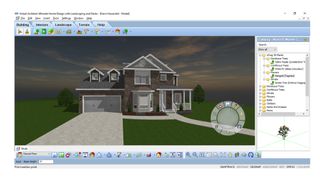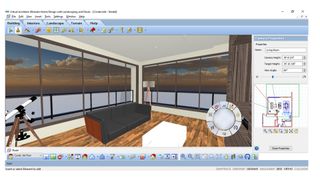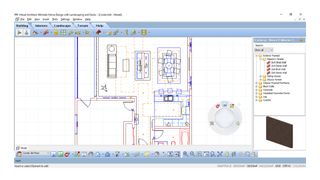Virtual Architect Ultimate 10.0 is designed to make any kind of project easy: whether it’s a kitchen makeover or a new build, an energy efficiency drive, or an extension, this app promises to make planning simple even if you’ve never used this kind of app before.
To see how Virtual Architect compares against the others we’ve reviewed, head to our guide on the best home design software.
Virtual Architect Ultimate Home Design: What you need to know
We like the Virtual Architect series – version nine of this app was previously one of our top picks – and while the interface design is really starting to show its age, the app itself is very simple and straightforward to use.
A big part of that is down to the app’s wizards, which guide you step by step through everything you need for a particular kind of project. Instead of leaving you with a blank screen, they guide you through the process of your remodel, new building, or landscaping. That really softens the learning curve that can make home planning apps a little bit intimidating, and with the House Builder wizard, you can get the app to take you through every step of designing an entire house. There are also plenty of sample designs that you can use as templates, or just as playgrounds to familiarise yourself with how everything fits together.

Virtual Architect Ultimate Home Design: Features
The differences between version nine and version ten of this app aren’t dramatic: there’s better functionality for doors and windows, the search tool makes it easier to find specific building materials, and there are new skyboxes for photorealistic backdrops. Version ten can also produce more impressive 3D visuals with new lighting in Presentation Mode. But the core of the app is largely unchanged, and that’s no bad thing. Virtual Architect Ultimate was already a very solid package with good drawing tools. It’s not all good news, though. As in previous versions, the app’s use of branded items is really useful if you live in the US.
There’s another similarity between version ten and version nine: it may run very slowly on low-powered laptops. Although the minimum specification here is a 2GHz or faster processor with 4GB of RAM and 1GB of graphics memory, that spec is not going to deliver the optimal experience: on a 2.5GHz Core i5-4200M processor with 8GB of memory and 1GB integrated graphics, the app ran very slowly in 3D mode.
The latest version of Virtual Architect Ultimate retains the strengths of its previous version. Although your plans will be created in 2D, the actual design takes place in a 3D environment. That’s really helpful if you don’t have an architectural background.
Tools such as automatic wall snapping and one-click window placement take a lot of the effort out of creating even complex plans, and if you’re already used to home planning software you can import your previous plans. We particularly like the tracing option, which you can use to mimic existing blueprints which you can then edit to suit your own requirements and which enables you to combine elements from different floorplans.
As before, you can also add your own digital photos to the design: you can even include pictures of your family to help you visualize how the finished project will look - or perhaps to persuade your partner that they’ll love what you’re designing.
We’re glad to see that the little tutorial window has been retained. That tells you what each tool does as you move the mouse over it. If you’ve tried some other home design apps you’ll know that some apps just leave you with a bunch of tiny icons that you have to try and decode without any help, so this is a very welcome feature.

Virtual Architect Ultimate Home Design: Landscaping features
As you’d expect from the name, this Landscape and Decks edition of the app can design outdoor areas as well as indoor ones. The Deck Builder wizard enables you to create plans for decked or paved areas, retaining walls, and even features such as gazebos, and the garden visualizer enables you to see what your outdoor areas will look like in different seasons and after the plants have reached their full sizes.
A lot of thought has clearly gone into the landscaping features, which can even tell you the best times to plant, prune or water your plants to ensure your outdoors is great all year round.
The terrain modeling is very flexible, the plant database is enormous, and the app also includes hardscape features such as fencing, sidewalks, driveways, and pathways. You’ll find useful items such as lighting, furniture, and water features in the accessory library.

Should you buy Virtual Architect Professional Home Design with Landscaping and Decks 10.0?
If your PC is close to the minimum requirements, this might not be the option for you: it does run slowly on low-powered hardware. But if you’ve bought your PC fairly recently and it comfortably exceeds the minimum system requirements Virtual Architect is a very capable app for design projects of any size. There’s a fantastic range of resources within this software and it really allows you to visualize your design.
If you’re only interested in landscape design, there may be a better program for you in our best landscape design software buying guide, while if you’re more focused on inside the home, you may want to look at our best interior design software buying guide.


